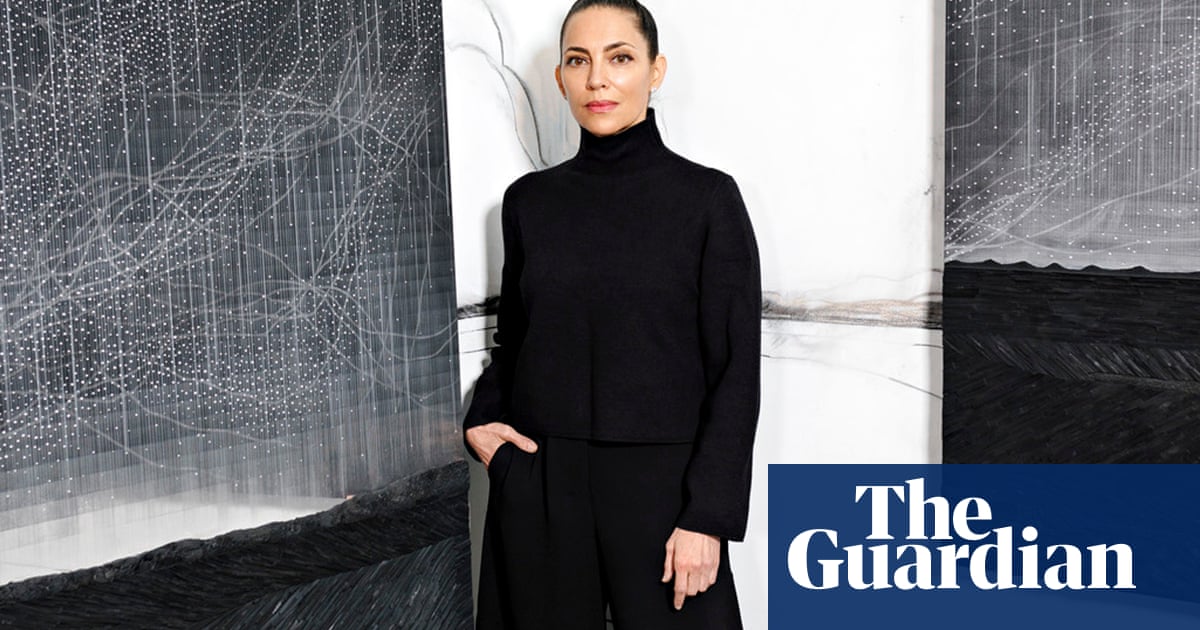Teresita Fernández is a landscape artist – but these are not landscapes as we know them. Rather than a spot on a map, her understanding of the term extends from the depths of the Earth to the cosmos, and from the cellular to the psychological. Her vast mosaic panel sculptures and wall reliefs of cartographies evoke galaxies, weather systems, oceans, and archipelagos, which appear to be continually in flux. “I think of landscape as being very expansive,” says Fernández, 56, who was born in Miami to Cuban exiles who had fled the 1959 revolution, and is now based in New York. “I’m drawing parallels between the movements of the sea and the cosmos, a flow that is also replicated in our bodies’ circulatory system.”
While Fernández’s work encompasses installation and film, she regards her practice as largely sculptural. Her vertiginous landscapes lure the viewer in with their magnificent colours and textures, composed of natural materials such as charcoal, gold, wood, clay and copper, but the lush surfaces often hint at hidden traumas relating to colonialism and other atrocities. There’s a widespread assumption, she says, that landscape is something passive, pleasurable or constructed, which allows her surreptitiously to “tuck” sociopolitical commentary into her work, creating what she calls “stacked landscapes” that are layered with multiple, often invisible histories.
Several of her sculptures, for instance, gesture toward the history of US exploitation of places such as Vieques, Puerto Rico and the Bikini Atoll, in the Marshall Islands for live munitions practice and atomic testing. “The history of land is the history of power,” says Fernández, speaking by phone from her Brooklyn studio. “What I’m trying to do is less about depicting a physical landscape and more about reflecting on what has been omitted in our ideas of a place.”
Fernández’s works have a somatic quality; you feel them before you respond to them intellectually. This is perhaps to do with her close attention to the context and histories of the materials she employs, what she describes as their “material intelligence”. Her forthcoming London show will be similarly experiential, engulfing viewers in a celestial oceanscape. The artist is presenting a floor-to-ceiling sculpture, and two new series of wall works, including two iridescent reflective mosaic panels Astral Sea I and II, after which the exhibition is titled. Made up of hundreds of handmade glazed ceramic tesserae, each a landscape in miniature, these monumental panels in dappled greens, blues and browns call to mind swirling satellite images of the Earth’s topography when seen from a distance. As the viewer passes in front of the works, the imagery dissolves into a dynamic kaleidoscope of colour, light and fractured reflections.
The second series, Stella Maris (Star of the Sea), is composed of large pulp paper works draped with netting, which both reveals and conceals abstract compositions beneath that suggest roiling seas melting into star-sprinkled skies. These works dramatically collapse scale so you can’t tell the size of what you’re looking at. “Whether it’s the rhythms of the stars or tides or the slow geologies of your own body, I’m thinking about these congruences of the intimate and the immense, the microscopic and the vast, both scales that are hard to see,” says Fernández.
The wall works are conceived as orbiting around the three-dimensional sculpture, Tether (Flotsam and Jetsam), which has a weight on the ground anchoring nets filled with malachite and azurite rocks at ceiling height, giving the impression that they are floating on the water’s surface above the visitor. In the push-pull between the lightness and solidity of the sculpture and the opposing senses of capture and rescue encapsulated by the nets, it’s hard not to think of migrants on overladen boats being swallowed by rough seas and, further in the past, of African bodies being thrown overboard from enslavers’ ships.
“I’m always looking through a sociopolitical lens. The violent legacy of the transatlantic slave trade is inextricably linked to Caribbean currents and waterways,” Fernández says. But she prefers to keep interpretations open. “I’m deeply committed to the complexity of the subtle. How objects have a gravitas that quietly affects your body is, I think, the most powerful aspect of sculpture.”
A recipient of a MacArthur Fellowship, AKA a “genius grant”, Fernández served as a member of Barack Obama’s US Commission of Fine Arts during his presidency, making her the first Latina to do so. She now has a show in New Mexico pairing her work with Robert Smithson, the first time the American land art pioneer has been placed in conversation with a living artist. The exhibition highlights common ground and differences such as the way ideas around land have evolved since the 1970s when (mostly white male) artists imposed their visions on areas of “wilderness” without considering who might have longstanding ties to them.
Fernández’s holistic conception of place and land as something animate and embodied was shaped by her experience of living in Japan in the late 1990s, and she returns there regularly. In contrast with the western, human-centric perspective that envisages the environment as a set for human activity, she was interested in the idea of a dialogue with it. “You look at the landscape, but it looks back at you,” she says. “It’s often why I use reflective surfaces in my work.”
By extension, Fernández considers her work to be figurative – “I’m the only person who thinks so,” she laughs. “I’m trying to reverse art historical conventions of the figure in the landscape,” she explains. “We are carbon-based matter; our bodies decompose into what we think of as landscape and the land holds everything that came before us. So rather than just looking at the landscape, we are, in fact, the landscape.”
